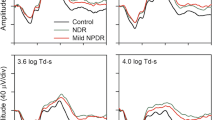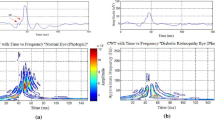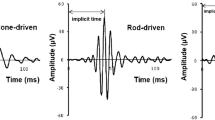Abstract
The oscillatory potentials of the electroretinogram in dark and light adaptation were evaluated by Fourier transform in 87 diabetics and 74 age-matched controls. The study consisted of four groups: normal control, no observable diabetic retinopathy, background diabetic retinopathy and proliferative diabetic retinopathy. A reduction in the amplitude of each oscillatory potential, the summed amplitudes, the area and the total power of the oscillatory potentials as well as delayed implicit time of each oscillatory potential peak in dark and light adaptation could be found in patients with background diabetic retinopathy and proliferative diabetic retinopathy. The amplitude of oscillatory potential 4 in dark adaptation and the total power of the oscillatory potentials in light adaptation seemed to be affected in patients with no observable diabetic retinopathy. The implicit time of oscillatory potential 2 in dark adaptation was valuable to distinguish between patients with no observable diabetic retinopathy and background diabetic retinopathy.
Similar content being viewed by others
Abbreviations
- NC:
-
normal control
- NDR:
-
no observable diabetic retinopathy
- BDR:
-
background diabetic retinopathy
- PDR:
-
proliferative diabetic retinopathy
References
Yonemura D, Tsusuki K, Aoki T. Clinical importance of the oscillatory potential in the human ERG. Acta Ophthalmol (Kbh) Suppl. 1962; 70: 115–23.
Bresnick GH, Palta M. Oscillatory potential amplitudes: Relation to severity of diabetic retinopathy. Arch Ophthalmol 1987; 105: 929–33.
Bresnick GH, Palta M. Temporal aspects of the electroretinogram in diabetic retinopathy. Arch Ophthalmol 1987; 105: 660–4.
Bresnick GH, Palta M. Predicting progression to severe proliferative diabetic retinopathy. Arch Ophthalmol 1987; 105: 810–4.
Coupland SG. A comparison of oscillatory potential and pattern electroretinogram measures in diabetic retinopathy. Doc Ophthalmol 1987; 66: 207–18.
Aylward GW. The scotopic threshold response in diabetic retinopathy. Eye 1989; 3 (pt 5): 626–37.
Juen S, Kieselbach GF. Electrophysiological changes in juvenile diabetics without re- tinopathy. Arch Ophthalmol 1990; 108: 372–5.
Brinchmann-Hansen O, Dahl-Jorgensen K, Hansen KF, Sandvik L. Oscillatory potentials, macular recovery time, and diabetic retinopathy through 3 years of intensified insulin treatment. Ophthalmology 1988; 95: 1358–66.
van der Torren K, van Lith G. Oscillatory potentials in early diabetic retinopathy. Doc Ophthalmol 1989; 71: 375–9.
Wachtmeister L. Basic research and clinical aspects of the oscillatory potentials of the electroretinogram. Doc Ophthalmol 1987; 66: 187–94.
Simonsen SE. ERG in diabetics. In: Francois J, ed. Clinical value of electroretinography. 20th International Congress of Ophthalmology Symposium. Basel: Karger, 1968; 403–12.
Brunette JR, Lafond G. Electroretinographic evaluation of diabetic retinopathy. Sensitivity of amplitude and time of response. Can J Ophthalmol 1983, 18: 285–9.
Lachapelle P, Benoit J, Little JM, Faubert J. The diagnostic use of the second oscillatory potential in clinical electroretinography. Doc Ophthalmol 1990; 73: 327–36.
Algvere P, Wachtmeister L, Westbeck S. On the oscillatory potentials of the human electroretinogram in light and dark adaptation, I: Thresholds and relation to stimulus intensity on adaptation to short flashes of light. A Fourier ananysis. Acta Ophthalmol (Kbh) 1972; 50: 737.
Vallabhan G, Kristiansen S, Price J, Young RSL. Effect of adaptation and wavelength on the power spectrum of human oscillatory potentials. Doc Ophthalmol 1988; 69: 145–51.
van der Torren K, Groenweg G, van Lith G. Measuring oscillatory potentials. Fourier analysis. Doc Ophthalmol 1988; 69: 153–9.
Author information
Authors and Affiliations
Rights and permissions
About this article
Cite this article
Li, X., Sun, X., Hu, Y. et al. Electroretinographic oscillatory potentials in diabetic retinopathy. Doc Ophthalmol 81, 173–179 (1992). https://doi.org/10.1007/BF00156006
Accepted:
Issue Date:
DOI: https://doi.org/10.1007/BF00156006




